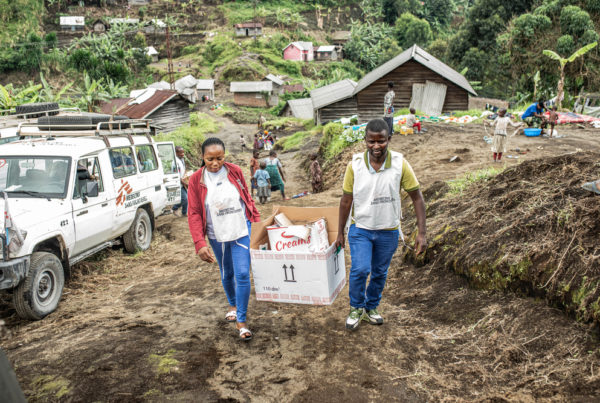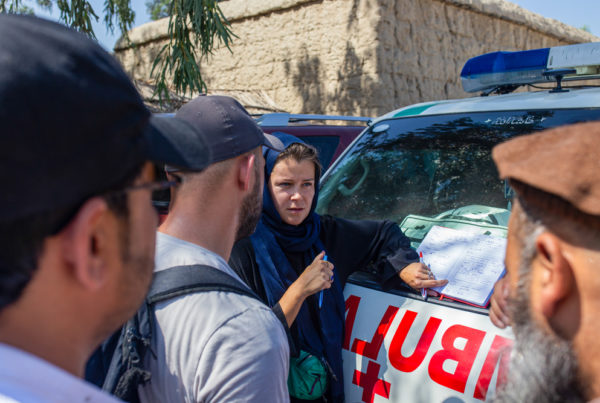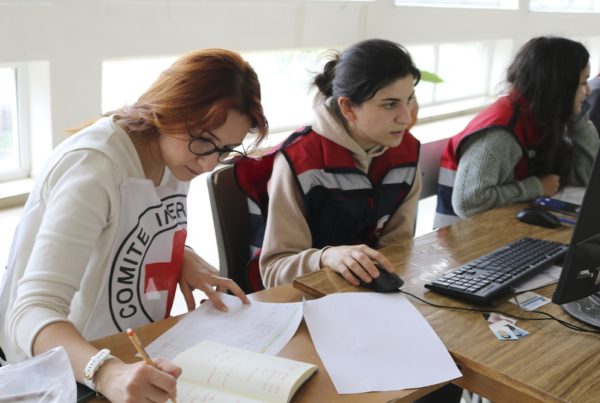
When conducting a humanitarian operation, it’s inevitable to negotiate with communities.
As the first affected by conflicts or disasters, communities must be part of the solution. But getting there requires opening a dialogue, discussing different options, listening to their concerns, and finally, reaching a compromise.
This is how negotiations ensue between humanitarians and communities. It’s about understanding communities’ needs and developing a response that is relevant and adapted to them.
This is especially true today as human crises become more prolonged and responses adopt a longer-term approach.
In this context, negotiating with communities becomes essential for successful humanitarian action.
Defining “negotiating with communities”
Negotiating with communities is a uniquely complex process because it requires time, a deeper understanding of the context, and building trust.
According to our research, when negotiating with communities, three key elements stand out:
- Negotiations are usually more personal. Instead of legitimacy from title, organisation, or years of experience, community members are often more interested in your personal life – if you are married, have children – where you come from and who your parents are.
- Negotiations tend to be more emotional. These negotiations can become more emotional because you interact directly with affected populations, often meeting them at home. Speaking about difficult and personal situations can be delicate, and emotions can often run high.
- Negotiations are frequently less formal. Intimacy, seeing how each other lives and knowing about your personal lives, can breed informality. Interacting with community members often happens in the community rather than at sites of humanitarian distribution or in offices, and these locations lend themselves to informality. For instance, it’s possible that you see each other at the market and interact with them as they go about daily activities, making each other “human” in the others’ eyes.
When negotiating with communities, a relational approach rather than a transactional approach is generally more effective. This requires unique negotiation skills, such as context analysis, network mapping and active listening.
Why is negotiating with communities important?
Negotiating with communities is at the heart of effective humanitarian aid and protection.
They are the first impacted and, therefore, the best placed to know what will help them.
As humanitarians, we are accountable to communities, and need to ensure community participation, transparent communication and feedback mechanisms as part of our response.
Effective community engagement requires developing relationships with communities, which often requires negotiating and reaching compromises.
In other words, building trust, resolving conflicts, and involving communities in decision-making can transform the impact of humanitarian work.

Now, let’s explore how you can effectively negotiate with communities.
1. Engage communities early and continuously
Whenever possible, involve communities in your programmes from the beginning.
Involving communities early ensures that their needs, insights, and priorities shape the design and delivery of aid interventions.
How to do it:
- Meet community representatives early in the planning process. (And if you’re having trouble identifying them, create a stakeholder mapping).
- Keep them informed and involved throughout, encouraging open dialogue and co-ownership.
Communities are more likely to support and sustain the interventions when they are part of the decision-making process. Trust built through early involvement eases problem-solving, smooths operations, and helps avoid conflicts later.
2. Prioritise clear and consistent communication
Maintaining clear and consistent communication is critical in preventing misunderstandings, managing expectations, and avoiding tensions.
If mismanaged, communication can lead to unmet expectations and tensions.
Clear and consistent communication ensures that everyone understands what is happening and why, reducing the risk of frustration.
How to do it:
- Train your team to share the same messages with the community, avoiding mixed signals.
- Use simple language to explain processes and updates.
Transparency reassures people, prevents misinformation, and builds trust. When communities feel well-informed, they’re more likely to cooperate and stay calm even during challenges.
Real-life negotiation example
We were working in a transit centre for newly arriving internally displaced people set up by the local authorities. Unfortunately, only 60 out of 240 rooms were available, and the showers didn’t have hot water.
We were there to provide food and assistance for the kids but were constantly being asked when the showers would be working again. It wasn’t our responsibility at all, but people don’t care. Once they see you wearing a vest, they think you have the information.
One of our team members said, “We’re not sure, but we were told that it will be provided shortly.”
The consequences of this unclear message were dramatic. In 15 minutes, we had 250 people blaming us and asking: “Where is the hot water? Why are you giving us food when we need to take a shower?”
After that, explaining that fixing the showers isn’t our responsibility doesn’t matter anymore; it doesn’t help.
In hindsight, the key messages need to be drilled into your team. For example, I always ask every single member of my team to repeat what they’re going to say, word for word.
We have the scripts printed out and memorised because when you speak with the 92-year-old grandmother, your human instinct is to help her. If you don’t have an answer ready, like “I’m sorry, I’m here to provide food assistance. If you have any other questions, ask X person. I can help you get there,” you can find yourself in a messy situation.
Clear information makes everyone’s job much easier.
– Anna Rollman, Mission Coordinator for Dobra Fabryka in Ukraine
3. Be prepared to manage conflicts
Tensions can arise when aid delivery doesn’t meet expectations, or resources are stretched thin. The ability to de-escalate conflicts and negotiate calmly is critical to prevent violent outbursts.
How to do it:
- Acknowledge frustrations and validate people’s concerns.
- Work with community representatives to mediate disputes and find common ground.
Active listening and respectful dialogue show empathy and transparency, helping to diffuse anger and build a stronger relationship with the community.
Real-life negotiation example
Sometimes, we make the mistake of avoiding conflict instead of just dealing with it.
For instance, one of the most emotionally taxing aspects of negotiating as a service provider is that 90% of our job is saying no. However, being able to do that consistently and compassionately is probably the strongest tool for any negotiation.
It’s helpful if you can explain why you turned down a request or show that principles apply to everyone in the community, including yourself.
On one occasion, while we were managing a community centre, a guy with a reputation for being a troublemaker complained that the teacher had mistreated him.
Since I didn’t know what had happened, I suggested we go talk to the teacher together.
I found out he had arrived late for class, and the teacher told him he couldn’t come in because we had strict rules for being on time.
When we arrived in front of the classroom, I saw the door was closed. So, I suggested we wait until the lesson was finished.
This simple act surprised him, and he said, “Oh, the rule also applies to you! Then that’s fine.”
The situation could have escalated quickly, but by simply showing him that I followed the rules as well, he calmed down.
– Giovanni Fontana, Co-founder and president of Second Tree in Greece
4. Humanise your approach
Treating people with dignity and kindness fosters goodwill and strengthens connections.
A human-centred approach transforms how communities perceive aid workers and the assistance they receive. Ask yourself: How can I negotiate respecting the community’s values and goals?
How to do it:
- Take time to listen to personal stories and concerns.
- Incorporate small, thoughtful gestures, like engaging with children or creating waiting spaces that are comfortable and welcoming.
When people feel respected and valued, they’re more likely to trust you and engage positively. Humanising aid also reinforces that your mission goes beyond logistics—it’s about caring for individuals.
5. Stay flexible and adaptable
In humanitarian settings, things rarely go according to plan. Flexibility is essential to respond to unexpected challenges without losing the trust of the community.
How to do it:
- Prepare your team to adapt quickly to changing situations.
- Involve the community in brainstorming solutions when things don’t go as planned.
If you want to build trust with the community, support community-led negotiations whenever possible. By showing that you’re willing to work with the community to find solutions, you strengthen their resilience and create smoother pathways to success.

Remember…
Negotiating effectively with communities isn’t just about solving immediate challenges—it’s about creating a partnership that supports long-term success. It requires building trust overtime through regular engagement. Time is a key factor, and communities’ memories are long.
Let’s recap the key steps:
- Engage early: Start building trust from the outset.
- Communicate clearly: Transparency and consistency prevent misunderstandings.
- Manage conflicts calmly: Address frustrations with empathy and respect.
- Humanise your approach: Treat individuals with care and dignity.
- Be flexible: Adapt to challenges with the community’s input.
By adopting these strategies, you’ll not only deliver aid more effectively but also build meaningful relationships with the communities you serve.
Together, you can navigate challenges and create lasting impact.
Good luck!



